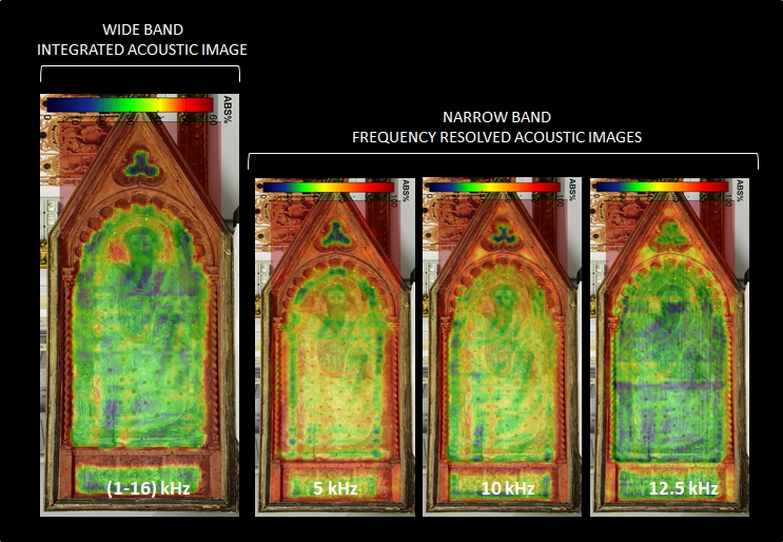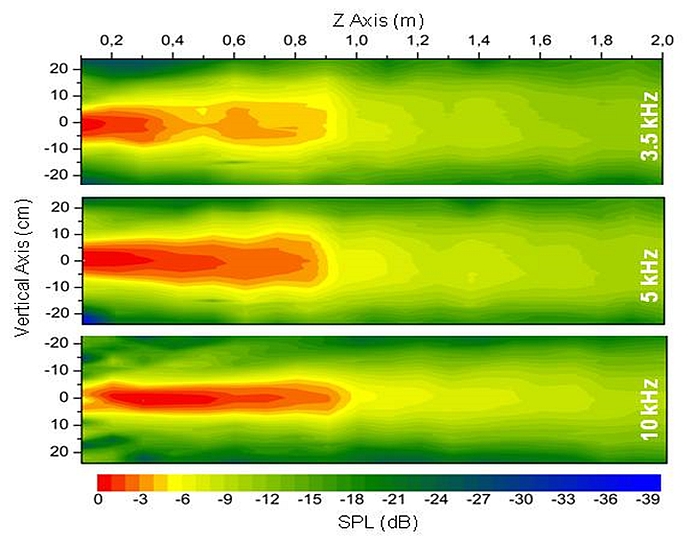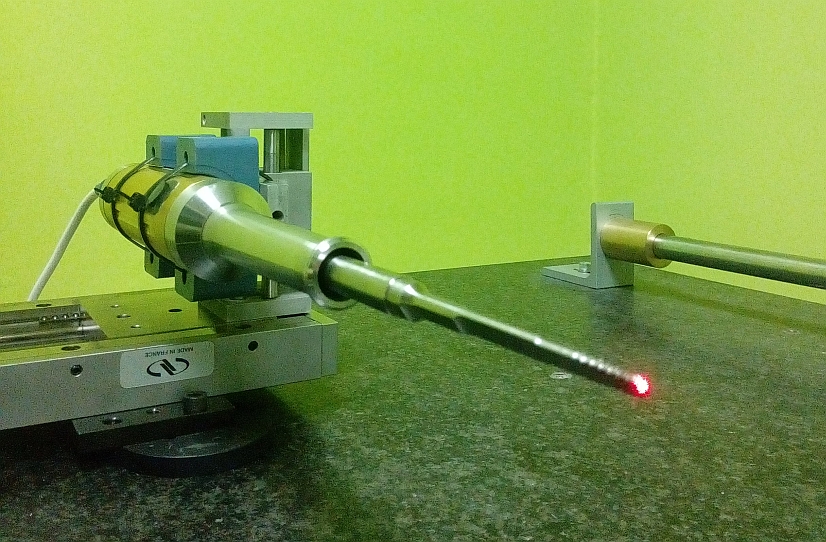Scope
| The research activity concerns the field of Applied Acoustics, mainly oriented to the following topics: – Non-destructive Testing and Evaluation (NDT&E) for the characterization of the acoustical properties of materials and composite structures; – Study and modeling of Acoustic Environments for the evaluation of the perceived quality of acoustic systems and environments by subjective tests; – Innovative devices and models supporting the safeguard processes of the Cultural Heritage. Research projects and consultancy services are carried out. The most relevant applicative sectors are: – Cultural Heritage; – Medical devices; – Acoustic Barriers, sound-absorbing and sound-isolating elements; – Acoustic characteristics in Architectural design. The related facility is the Laboratory of Acoustics Research applications for Cultural Heritage – LARCH. |



Subtopics
| Non-destructive Testing and Evaluation The activity encompasses the development and use of Frequency Resolved Acoustic Imaging (FR-AI) techniques in the audio frequency interval, and of Laser Doppler Vibrometry jointly with contacless acoustic excitation. The main applicative field concerns the diagnostics of cultural heritage, in particular different typologies of paintings such as frescoes, mural paintings, glazed ceramics, panel paintings. The conservation state of these artworks is correlated to their structural damage due to detachments, flaws, general adherence failure between adjacent elements; these defects behave as vibrating systems under the action of an external acoustic pressure field. Other testing facilities allow the characterization of acoustic barriers, sound-absorbing and sound-isolating elements. |
| Study and Modeling of Acoustic Environments Sound environments can be studied, characterized and modelled in the facilities of the LARCH Laboratory. Subjective tests provide indication about the perceived quality of soundscapes. And the virtual reconstruction of the acoustical properties of indoor and outdoor environments helps the realization of architectural projects, in modern and antique buildings. Acoustic systems too, such as innovative highly directive sources, has been studied and characterized. Usefull applications in the Cultural Heritage sector, supporting the exhibition spaces implementation or the optimization of the acoustical aspects in media production. |
Selected projects
| REMEDIA – RicErca e diagnostica di MEtodi di contrasto al Deterioramento causato dall’umidItA’ nei Beni Culturali L’ENEA assieme al CNR, partner del progetto, ha ottenuto il finanziamento per il progetto denominato REMEDIA con l’obiettivo di portare ad una avanzata maturità tecnologica il dispositivo diagnostico acustico denominato ACoustic Energy Absorption Diagnostic Device (ACEADD), sviluppato a livello di sistema di laboratorio dal partner CNR. L’uso dell’Imaging Acustico in banda audio risolto in frequenza è la tecnica innovativa scelta per effettuare le analisi diagnostiche nel settore dei Beni Culturali. Un precedente prototipo di laboratorio, già impiegato in sperimentazioni in campo e correntemente ad uno stato di sviluppo tecnologico a livello di modello di sistema con impiego in ambiente pertinente (TRL 6) è la base da cui partire per migliorare le innovazioni ed elevare la maturità tecnologica (TRL 7). Il dispositivo finale sarà provato in ambienti operativi reali e dovrà possibilmente interessare gli addetti al settore anche a livello commerciale. Le finalità del progetto sono l’innovazione tecnologica, e più nello specifico la realizzazione di un prodotto attrattivo dal punto di vista commerciale, avvalendosi a tal fine della collaborazione delle aziende laziali operanti nel settore dei beni culturali. REMEDIA ha l’ambizioso obiettivo di stimolare sia l’offerta che la domanda del prodotto diagnostico, considerando l’attuale mancanza di prodotti similari commercialmente disponibili, e la conseguente debolezza di offerta come di domanda. ENEA partecipa con il Laboratorio Diagnostica e Metrologia (DIM) della Divisione Tecnologie Fisiche (FSN-TECFIS) nel centro di Ricerche di Frascati. Il CNR partecipa con 3 istituti: L’Istituto di Ingegneria del Mare (INM), l’Istituto per i Sistemi Biologici (ISB), e l‘Istituto di Scienze del Patrimonio Culturale (ISPC). Capofila (mandatario): ENEA Partner (mandante): CNR Budget: 149.902.37 € a fondo perduto Durata: 24 mesi dal 15/04/2021 al 14/04/2023 Coordinatore progetto: Francesco Colao (ENEA) – Referente per CNR: Paola Calicchia (CNR INM) – Il progetto di ricerca è stato presentato da ENEA e CNR nell’ambito dell’Avviso pubblico “Progetti di Gruppi di Ricerca 2020” del POR FESR 2014-2020 della regione Lazio per l’area di specializzazione della Smart Specialisation Strategy Regionale (S3) “Beni culturali e tecnologie della cultura” [CUPI15F21000280002; Codice Progetto POR A0375E0010]. Scheda del Progetto: https://file.sic.rm.cnr.it/index.php/s/t6CuApAfkK71kjn Poster del Progetto: https://file.sic.rm.cnr.it/index.php/s/fMOREcAx76XQiG4 Comunicazione Capofila: https://www.enea.it/it/fusione-e-sicurezza-nucleare/progetto-remedia |
| Cultural Heritage Open Laboratory System – CHeLabS CHeLabS promotes the research and the innovation in the Cultural Heritage safeguard, through a model of territorial system based on the principles of the Open Access and Sharing Culture. CHeLabS addresses the vision of a distributed laboratory, realized by implementing the access policies, the technologies, the research activities and training within the patrimony itself. In 2018 CHeLabS has lunched a web-based platform with an interactive survey to start sharing knowledge and new ideas. The heritage professionals and the citizens are both invited to contribute to identify the needs for knowledge enhancement and for technology development, to identify the heritage value perceived by the community, and to elicit new ideas on the expected learning experiences inside the cultural spaces. During the year 2018 the CHeLabS Survey has been among the initiatives for the EYCH 2018. The project also includes an educational and creative programme for the students attending the primary and high school, the CHeLabS Juniors initiative. The initial phase of the CHeLabS project has been funded in the framework of the Project SM@RTINFRA – SSHCH of the C.N.R. – DSU (MIUR MD n. 973 of 25.11.2013). Project page: http://chelabs.idasc.cnr.it/ |
| Project ADAMO (Technologies of Analysis, Diagnostics and Monitoring for the preservation and restoration of Cultural Heritage) – DTC Lazio The group participates to the ADAMO project, in the framework of the Technological District Cultural Heritage of the Latium Region (DTC), in the WP4 – In-situ and remote analysis and diagnostics, providing non-invasive diagnostic tools (Acoustic Imaging methods). On site investigations were carried out in the Curch of San Nicola in Carcere (Rome), and in the Ariosto Hall of Palazzo Chigi (Ariccia). Project page: http://progettoadamo.enea.it/ Technological District page: https://dtclazio.it/ Experimental Results: Sala dell’Ariosto – Graecia Vetus |
| Roman Theatres Within the framework of the PhD research activity of Dr. Cristina Manzetti, carried out at the Institute for Mediterranean Studies (FORTH), an interdisciplinary study has involved disciplines as architecture, archaeology, acoustics and computer science. A Virtual Acoustics Analysis of Ancient Roman Theatres in Crete, realized in the LARCH facilities, has demonstrated how these disciplines can be integrated in order to achieve new information about ancient buildings that are now almost completely destroyed, and how they can improve the valorization of these monuments. The results help the archaeological and architectural interpretation, contributing to a thorough database freely accessible online, and constituted the base of an 3D immersive reality application for Oculus Rift usefull for the knowledge dissemination. Dr. Cristina Manzetti, PhD Thesis Project page: https://romantheatres.ims.forth.gr/ |
| Project BioACHs Biodegradation Assessment for Cultural Heritage surface and substrates – BETA Technological Center – Universitat de Vic-Universitat Central de Catalunya (UVIC) The activity of microorganisms such as bacteria, fungi, algae and lichens, and their interaction with hosting material surface and substrate having specific chemical-physical characteristics are considered among the main agents responsible for aesthetic and structural damage to Cultural Heritage (CH) artefacts and structures. The aim of BioACHs is to design and develop an open source hardware, portable device for non-destructive analysis and monitoring of biofilm formation, growing and interactions on CH surfaces and substrates. The device developed within BioACHs would enhance CH operators ability to provide a fast and accurate identification of microorganisms, monitoring in progress biodegradation processes, and plan and check conservation intervention. Dr. Mainardo Gaudenzi Asinelli, Individual Fellowship under the TECNIOspring PLUS Programme BioACHs Project News page: https://www.uvic.cat/es/noticias/el-centro-tecnologico-beta-obtiene-tres-nuevas-ayudas-tecniospring-de-accio BETA Technological Center page: https://mon.uvic.cat/ct-beta/ |
People
| Research Scientists and Engineers Paola Calicchia, |
| Research Fellows and PhD Students Sara De Simone, |
| Visiting Researchers Mainardo Gaudenzi Asinelli, |
Selected publications
- P. Calicchia, S. De Simone, L. Di marcoberardino, P. Verardi, Exploring the potential of a frequency resolved acoustic imaging technique in panel painting diagnostics, Measurement Vol. 118, pages 320-329 (Mar 2018, online Aug 2017).
DOI: 10.1016/j.measurement.2017.08.017. - P. Calicchia, L. Pitolli, P. Salonia, The Cultural Heritage Open Laboratory System (CHeLabS). Unfolding a cultural heritage-driven development in science and technology, Acta IMEKO, vol. 6, no. 3, article 2, September 2017, identifier: IMEKO-ACTA-06 (2017)-04-02 . DOI:10.21014/acta_imeko.v6i3.442 .
- P. Calicchia, S. De Simone, V. Gallo, Progettazione e allestimento del Laboratorio di Psicoacustica del CNR-IDASC, Atti del 41° Convegno Nazionale dell’Associazione Italiana di Acustica, Pisa, 17-19 giugno 2014. [PDF, POSTER]
- L. Di marcoberardino, P. Calicchia, S. De Simone, Gli Array Parametrici: dalla loro scoperta ai giorni nostri, Rivista Italiana di Acustica Vol. 37, N. 3-4, Dec. 2013. [PDF]
S. De Simone , L. Di marcoberardino, P. Calicchia, Caratterizzazione di sorgenti acustiche non convenzionali per l’impiego nei test non distruttivi, Rivista Italiana di Acustica Vol. 37, N. 3-4, Dec. 2013. [PDF] - L. Di marcoberardino, P. Calicchia, S. De Simone, Gli Array Parametrici: dalla loro scoperta ai giorni nostri, Rivista Italiana di Acustica Vol. 37, N. 3-4, Dec. 2013. [PDF]
- S. De Simone , L. Di marcoberardino, P. Calicchia, Caratterizzazione di sorgenti acustiche non convenzionali per l’impiego nei test non distruttivi, Rivista Italiana di Acustica Vol. 37, N. 3-4, Dec. 2013. [PDF]
- P. Calicchia, S. De Simone, L. Di Marcoberardino, J. Marchal, Near- to far-field characterization of a parametric loudspeaker and its application in non-destructive detection of detachments in panel paintings, Applied Acoustics 73 (12), pp. 1296–1302, Special Issue: Parametric Acoustic Array: Theory, Advancement and Applications, (2012), DOI:10.1016/j.apacoust.2012.06.001.
- P. Bellucci, P. Calicchia, M. Cerchiai, A. Giovannetti, R. Grecco, La caratterizzazione acustica delle pavimentazioni antirumore: stato dell’arte, ANAS E-journal (2011).
- P. Bellucci, G. Brambilla, P. Calicchia, M. Cerchiai, A. Giovannetti, R. Grecco, P. Leandri, G. Licitra, M. Losa, Attenuazione del rumore stradale – Interventi di mitigazione sonora alla sorgente, World Road Association AIPCR BOOK – ISBN 978 88 905397 9 (2010).
- G. B. Cannelli, P. Calicchia Nondestructive acoustic method and device, for the determination of detachments of mural paintings, EU Patent EP1190243B1 (2006); US Patent US 6728661 (2004); PCT N. PCT/IT00/00244 (2000); IT Patent N. RM 99 A000410 (1999). Patents/EP1190243B1.

